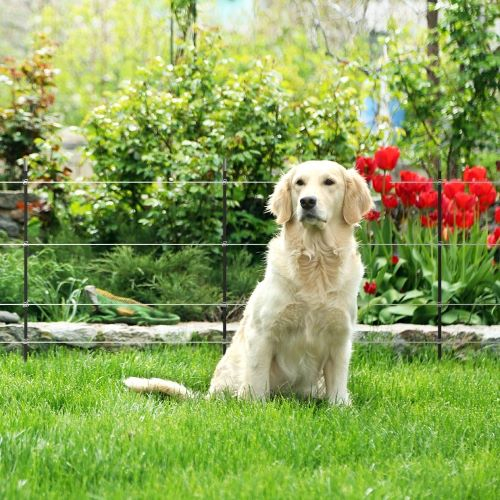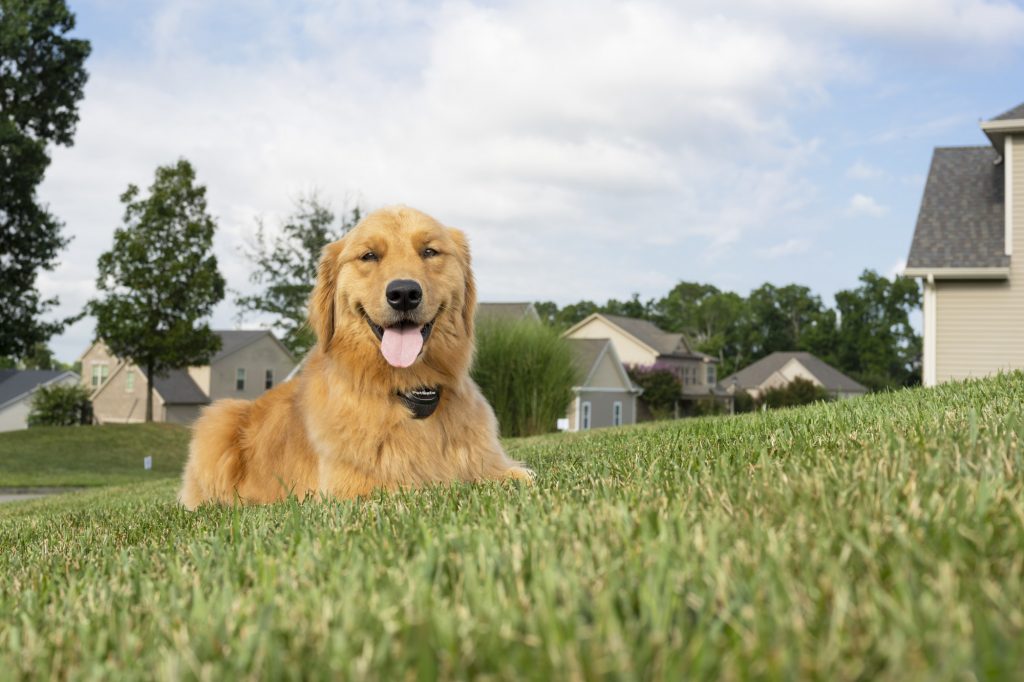Wireless fences for dogs are becoming increasingly popular among pet owners who want to keep their dogs safe and contained in a specific area without the use of traditional physical fences. These fences work by using a central transmitter that emits a signal to a receiver located on the dog’s collar. When the dog approaches the boundaries set by the transmitter, the collar emits a warning signal, followed by a static correction if needed. In this article, we will discuss the various features and benefits of wireless fences for large dogs and how they compare to other dog containment systems.
Benefits of Using a Wireless Fence for Large Dogs
Wireless fences are an increasingly popular option for large dog owners looking for a safe and effective way to contain their pets. Compared to traditional fences, wireless fences offer several significant benefits.
One of the most significant advantages of a wireless fence is that it’s much easier to install than a traditional fence. With a wireless fence, there’s no need to dig any holes or install physical barriers. Instead, pet owners can simply set up the wireless transmitter and use the signal to create a circular boundary around their property.
Another advantage of wireless fences is that they’re particularly effective at keeping pets safe from wild animals, swimming pools, and traffic. Unlike traditional fences, which can be breached easily by wild animals, a wireless fence will create a barrier that is much harder for animals to penetrate. Additionally, because the fence is invisible, it won’t obstruct any view of traffic or water, allowing pets to safely roam while greatly reducing the risk of accidents.
Many wireless fences come with rechargeable batteries, which can save pet owners a significant amount of money on replacement batteries over time. These systems also often have adjustable static correction levels that can be tailored to fit the dog’s size and temperament. Additionally, because many wireless fences come with waterproof collars, even dogs who love to swim won’t cause any unnecessary damage to the equipment, offering additional peace of mind.
Other benefits of wireless fences include the ability to create custom shapes, such as including or excluding flower beds and other features. Rechargeable batteries also allow for continuous operation, and many systems offer additional collars for multi-dog households. Some even come with smart collars that allow for features like tone-only mode and static-free reentry, ensuring that dogs are always safe and happy.
Types of Wireless Fences for Large Dogs
Wireless fences are a popular option for pet owners who want to keep their dogs contained without the hassle of installing traditional physical fences. However, with so many options available on the market, it can be overwhelming to choose the right one for your large dog. In this article, we’ll explore the types of wireless fences specifically designed for large dogs to help you make an informed decision.

Invisible Dog Fences
Large breed dogs need enough space to roam and exercise, but letting them run around outside without any supervision can be both concerning and dangerous. This is where invisible dog fences can come to your aid. These pet containment systems provide a safe and hassle-free way to keep your large dogs within the confines of your yard without the need for traditional fencing.
Invisible dog fences are named as such because they are designed to be unobtrusive, unlike physical fences which can sometimes be an eyesore. They use a wired or wireless boundary system to keep your pets safe and prevent them from escaping your property. Invisible dog fences are known for their reliability, affordability, and effectiveness in containing your pets in a designated area.
Invisible dog fences use a transmitter to send a radio signal to a dog collar equipped with a receiver that your pet wears. The signal communicates with the collar to send a warning beep or vibration when your dog approaches the boundary’s edge. If the dog ignores the warning beep and crosses the boundary, the collar applies a harmless static correction. This gentle static correction helps your dog understand their boundary while keeping them safe within the designated area.
The wired fence system uses an underground wire placed just below the surface to create a boundary line. The wire carries a signal that communicates to the collar, which prompts your dog to change direction or stop moving altogether. The collar picks up the signal from the wire only in the designated areas and applies a static correction when the dog crosses the boundary.
Wireless fence systems, on the other hand, are more advanced and require no upfront or in-ground work to install. Instead of an underground wire, the wireless system uses the transmitter to emit a circular boundary signal around a central location. The wireless fence system requires no digging or burying, making it convenient to install and remove.
There are many invisible dog fence systems out there, but some of the most popular are:
1. PetSafe Wireless Containment System – One of the most trusted and reliable wireless dog fence systems on the market. It provides a circular boundary of up to ½ acre and includes five different static correction levels, waterproof collars, and a rechargeable battery.
2. Extreme Dog Fence System – This wired fence system is an excellent option for those with larger properties or extensive boundary requirements. It comes with an impressive 1000 feet of underground wire, collars with static correction levels and rechargeable batteries, and a versatile indoor transmitter for straightforward installation.
3. Havahart Wireless Radial Shaped Dog Fence – This wireless system is perfect for those who want a more customizable boundary shape. It comes with a circular boundary area up to 11 feet deep and a waterproof collar with five different static correction levels and a 6-month battery life.
Traditional Fences
When it comes to containing large dogs, traditional fences are often the go-to option. There are several types of traditional fences available, including chain link fences, wooden fences, and brick walls.
Chain link fences are a popular choice for pet owners because they are affordable, durable, and offer good visibility. However, they are not the most aesthetically pleasing option and may not be the best choice if you have a particularly strong or aggressive dog.
Wooden fences, on the other hand, offer a more attractive option, with various styles available to complement your home’s exterior. They also provide more privacy and are typically sturdier than chain link fences. However, wooden fences require more maintenance, including regular cleaning and staining to prevent rot and damage from weathering.
For those looking for ultimate security and privacy, brick walls offer a highly effective solution. They are virtually indestructible and offer complete privacy and security. However, they are also the most expensive option and require a professional installation.
When considering traditional fences for large dogs, it is important to take into account the size and strength of your dog, as well as the surrounding environment. For instance, if you have neighbors with small children or small pets, a fence that provides more visibility may be a better option. Additionally, if you live in an area with a lot of wildlife, a fence that provides more security may be necessary to prevent your dog from escaping and coming into contact with wild animals.
Electric Fences
Electric fences offer pet owners a convenient and cost-effective way to contain their large dogs in a specific area without the need for traditional fences. These fences work by creating a circular boundary that emits a mild electric shock to your dog when they cross it, teaching them to stay within the designated area.
One of the main advantages of electric fences for dogs is the ease of installation and affordability compared to traditional fences. Unlike traditional fences that require professional installation and maintenance, electric fences can be installed by pet owners themselves using wired or wireless options. This makes them an ideal option for renters or those who want to avoid the high costs of traditional fencing.
There are two types of electric fences available for large dogs: wired and wireless. Wired fences require the installation of an underground wire that emits a signal, while wireless fences use a transmitter to send out a signal that creates a circular boundary. Both types have their advantages and disadvantages, and it is essential to consider your dog’s behavior and size when choosing the right one for your needs.
Wired fences are an excellent option for large dogs that are excitable and may try to escape. They are also suitable for homeowners who want to create a precise boundary, such as around flower beds or pools. Wireless fences, on the other hand, are ideal for those who want a more flexible and portable option that can be moved around if needed.
Virtual Fence
A virtual fence is a type of wireless fence that uses GPS technology to create an invisible boundary for dogs. The purpose of a virtual fence is to contain dogs safely within a designated area without the need for physical barriers like traditional fences. Virtual fences are becoming increasingly popular among pet owners for their convenience and ease of use compared to other fencing options.
To create a virtual fence, a pet owner needs to attach a GPS-enabled collar to their dog. The collar communicates with a wireless transmitter that sends a signal to track the dog’s location in real time. As the dog approaches the virtual boundary, the collar emits a warning signal or a mild static correction to prevent them from crossing the boundary.
One of the most significant benefits of virtual fences is their flexibility and portability. Unlike traditional fences, virtual fences can be modified and moved around easily, making them an ideal option for pet owners who may change their home or yard layout. Virtual fences are also less expensive than traditional fences, which can save pet owners money in the long run.
There are several advanced virtual fence systems available in the market that utilize GPS technology to provide unique features. One such system is the SpotOn GPS fence, which allows pet owners to create and save multiple virtual boundaries for their dogs. The system also comes with a mobile app that provides real-time tracking of the dog’s location and alerts the owner if the dog leaves the designated area.
Before purchasing a virtual fence, pet owners should consider several factors such as the size and breed of the dog, yard dimensions, interference, and power source. Virtual fences may not be suitable for very large or very small dogs, and interference from nearby structures or environmental factors can affect the system’s effectiveness. Pet owners should also ensure that their virtual fence has a reliable power source and collar battery life.
Wired Fences
If you’re a pet parent who wants to keep your large dog safe and secure within your property without a traditional fence, a wired fence might be the perfect solution for you. Wired fences consist of a buried wire around the perimeter of your yard, which is connected to a transmitter and a receiver on your dog’s collar.
The transmitter sends out a signal that is picked up by the receiver in your dog’s collar. When your dog approaches the boundary set by the wire, the collar will beep to warn them. If your dog continues to approach the boundary, a mild electric shock will be delivered through the collar providing a negative reinforcement to keep your dog within the safe zone.
A wired fence is a great choice for pet parents who want a customizable containment system that allows more freedom than traditional fences. They can be installed to any shape or size, customized according to the contours of your yard, and allow your dog to roam within the designated boundary without any extra supervision.
The biggest advantage of a wired fence over traditional fences is that it’s an invisible way to create a barrier that doesn’t obstruct your view or disrupt the aesthetics of your yard. Wired fences are also a much cheaper option than traditional wooden or chain-link fences, which can be expensive to install and maintain.
Rechargeable Battery-Powered Systems
Rechargeable parents who want a wireless fence that is eco-friendly and cost-effective. These systems use a rechargeable lithium-ion battery to power the collar receiver, eliminating the need for disposable batteries. This makes rechargeable battery-powered systems much more eco-friendly than wired fences that use disposable batteries, which can be harmful to the environment.
Another benefit of rechargeable battery-powered systems is that they are cost-effective in the long run. Pet parents can save money by not having to constantly replace disposable batteries, which can add up over time. Additionally, most rechargeable batteries last for several years before needing to be replaced, so pet parents won’t have to worry about replacing them too often.
One disadvantage of rechargeable battery-powered systems is that they may not be as reliable during power outages. If there is a power outage and the fence is not able to recharge, the collar receiver may become ineffective and your dog may be able to leave the designated boundary. To overcome this potential issue, some manufacturers have designed systems with backup batteries or the ability to be charged using a car battery.
When choosing a rechargeable battery-powered system, it’s important to consider the battery life and charging time. Some systems have a short battery life and require frequent charging, which can be inconvenient for pet parents. Others have longer battery life and faster charging times, which can make them a more practical option for busy pet parents.
Overall, rechargeable battery-powered systems offer several benefits for pet parents who are looking for a wireless fence. With eco-friendly and cost-effective solutions, rechargeable battery-powered systems are a great choice for pet parents who value convenience and sustainability.
Ground Boundary Fence Systems
Ground Boundary Fence Systems is a reliable and customizable solution for pet containment that requires burying a wire to define the boundary line. These types of fences, also known as in-ground fences, emit a signal that acts as a boundary line for the dog, and if they cross it, they will receive a static correction through their collar.
Unlike wireless fences, Ground Boundary Fence Systems are not portable and require upfront installation. However, they provide a more reliable solution for pet containment, as they are not susceptible to signal interference or power outages.
These types of fences are especially useful for pet parents who want to keep their dogs in certain areas of their yard or keep them away from specific outdoor features, such as flower beds or a swimming pool. The ability to customize the boundary line by burying the wire in a specific pattern allows pet parents to create a boundary that fits their individual needs.
Ground Boundary Fence Systems typically come with static correction levels that can be adjusted based on the dog’s personality and temperament. This feature provides a tailored approach to pet containment that ensures the dog’s safety while not causing undue stress.
Maintenance and Troubleshooting Tips for Wireless Dog Containment Systems
Wireless dog containment systems are a popular choice among pet parents who want to provide a safe and secure environment for their furry family members. However, like all electronic devices, these systems require proper maintenance and occasional troubleshooting to ensure that they continue to function effectively. In this article, we will provide some tips and tricks for maintaining and troubleshooting your wireless dog containment system, so you can have peace of mind knowing that your dog is safe and secure at all times.

Power Outages and Interference
Wireless fence for large dogs are a convenient and effective way to keep your furry friend safe and contained within a specific area without the need for traditional physical fences. However, these devices can face certain challenges, especially in the event of power outages and signal interference.
Power outages can occur unexpectedly and can pose a significant problem for the wireless fence containment system, causing it to stop working altogether. To overcome this issue, it is highly recommended that pet owners invest in a UPS (Uninterruptible Power Supply), which acts as a backup battery for the transmitter. This not only ensures that your pet remains safely contained even during a power outage but also prevents any damage to the fence system.
Apart from power outages, wireless dog fences can also face signal interference, which can lead to the system malfunctioning or failing to work altogether. Other electronic devices, such as kitchen appliances and light fixtures, can disrupt the signal of the dog fence. This issue can be remedied by relocating the transmitter to a different outlet in your house or by changing its position to avoid interference.
Static Correction Levels and Waterproof Collars
Static correction levels and waterproof collars are crucial components of wireless dog fences. When your pet attempts to cross the boundary of the wireless fence, static correction levels come into play. These levels of correction are designed to dissuade your pet from crossing the fence boundary without causing harm. The correction levels vary from soft to strong, and you can adjust them depending on the size and temperament of your pet.
It is important to note that static correction levels should not be used as a form of punishment. They are intended to be a gentle way of guiding your pet to stay within the established boundary of the wireless fence. The levels of correction should be used only after the pet has received proper training, and only as necessary.
On the other hand, waterproof collars are an essential component of any wireless dog fence. These collars are designed to fit securely around your pet’s neck and are equipped with sensors that detect when the pet is near the boundary of the wireless fence. They can be adjusted to fit any size of the pet, and they are completely waterproof, making them ideal for use in swimming or rainy environments.
As with any electronic device, maintaining your wireless dog fence and collar is necessary to ensure that it functions correctly. Ensure that the collar battery is charged, and the collar is securely fastened around your pet’s neck. Remember to adjust the static correction levels according to your pet’s temperament and size.
Checking the Circular Boundary Range and Maintenance Schedule
When it comes to ensuring your wireless dog containment system is functioning properly, regularly checking the circular boundary range and creating a maintenance schedule is crucial. Here are some steps to follow:
1. Walk the perimeter of your dog’s roaming area: To check the circular boundary range, start by walking the entire perimeter of your dog’s roaming area while carrying the collar receiver. Make sure to listen to the warning signal or observe any static correction levels while doing so.
2. Mark the boundaries: Once you have determined the circular boundary range, mark the boundaries using flags or spray paint. This will help you remember where the boundaries are and ensure that they are maintained over time.
3. Test the collar receiver: Next, test the collar receiver to make sure that it’s compatible with the system. Make sure that the receiver beeps or vibrates when you approach the boundary and that it gives an appropriate static correction level when necessary. Test each of the different static correction levels to determine the right level for your dog.
4. Create a maintenance schedule: To ensure that your wireless dog containment system remains effective over time, it is crucial to create a maintenance schedule. The schedule should include testing the system monthly, checking the collar battery, and the system battery life. Ensure that the boundaries are still marked and that they have not been obscured by grass, flowers, or other plants that have grown in the area.
By regularly checking the circular boundary range and maintaining your wireless dog containment system, you can help keep your dogs safe and prevent them from wandering off into dangerous areas. Remember to always be aware of wild animals or swimming pools in the area, and adjust the boundaries accordingly.
Conclusion
In conclusion, choosing the right wireless fence for your large dog requires careful consideration of a variety of factors. It’s important to weigh the pros and cons of each type of fence before making a final decision. Terrain and yard dimensions, the number of dogs using the system, collar battery life and level of static correction, and the range of the circular boundary are all significant factors to consider.


